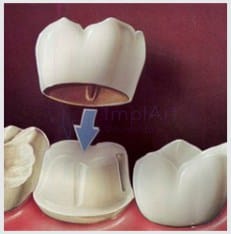Metal-ceramic crowns and prostheses – traditional porcelain
Metal-ceramic crowns and prostheses are a classic option for people who have lost one or more teeth, to fully or partially cover a damaged crown or to improve the appearance, shape or alignment of teeth. Porcelain dental crowns are the popular name for metal-ceramic crowns, but today there are other types of porcelain for dental crowns.


Advantages of metal-ceramic prostheses
The positive points of metal-ceramic crown technology are their strength, high level of durability and appearance. With the new generations of different porcelain formulations, they look very similar to natural teeth. In their final finish, porcelain prostheses are given a special shine so that they don’t darken under the effect of black light.
How crowns are made from this material
A metal-ceramic crown consists of an internal metal structure, which is then veneered with porcelain (ceramic).


Metal-ceramic crowns have a great ability to blend in with the natural coloring of neighboring teeth. They can be used, for example, to replace a large restoration, protect a weakened tooth, make prostheses for one or more teeth, restore a dental implant or a full prosthesis to replace all the teeth in an arch. In short, when making a prosthesis, the patient and the dentist will decide on the best option for each person.

If it’s a metal-ceramic prosthesis, the specialist will choose the correct color so that it matches your natural teeth. Before your permanent porcelain crown is made, you will receive a temporary dental crown. In some cases where natural teeth are reconstructed using porcelain crowns, the root canal-treated teeth will need an internal reinforcement pin called a dental core.


Disadvantages of the metal-ceramic crown
The structural metal of the metal-ceramic is the main strength of the metal+porcelain prosthesis (resistance), but it is also its main disadvantage. The internal metal of the prosthesis or dental crown can make the work less aesthetic because:
- A dark spot may appear on the tooth due to the translucency of the metal.
- Dentures can turn gray
- A metal-ceramic porcelain crown can show metal on its edge, leaving the gums dark
- The porcelain of dentures can detach one day, leaving the bare metal exposed
- They are difficult to repair in the event of a fracture
- They are less living than natural teeth or more modern prostheses such as dental zirconia.

What if I don’t want metal in my mouth?
Another option to metal ceramics can be metal-free porcelain, which is very suitable for front teeth or for people who are allergic to metals. Nowadays there are several types of metal-free crowns, including computer-made crowns, in which the molds are not made with putty but with digitized molds.
ImplArt Odontologia has its own dental laboratory within the clinic. This certainly facilitates communication between dentists and prosthodontists and reduces the time it takes to make the prosthesis. The in-house prosthetic laboratory is fully equipped with digital technologies and 3D tooth printers. If you have any questions, please contact our team or book an appointment with our specialist team. We’d be delighted to hear from you!

 Agende sua consulta agora por WhatsApp
Agende sua consulta agora por WhatsApp







































